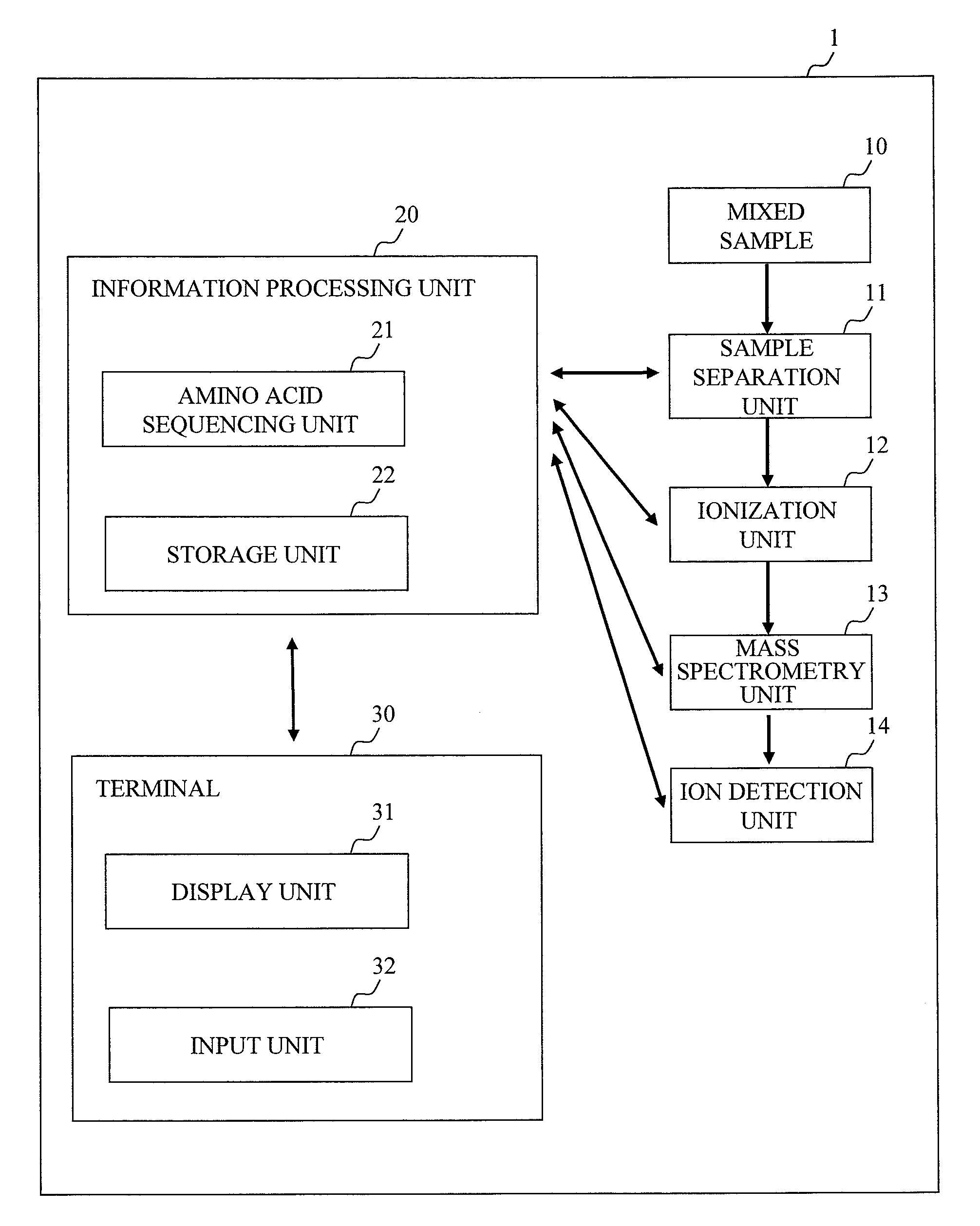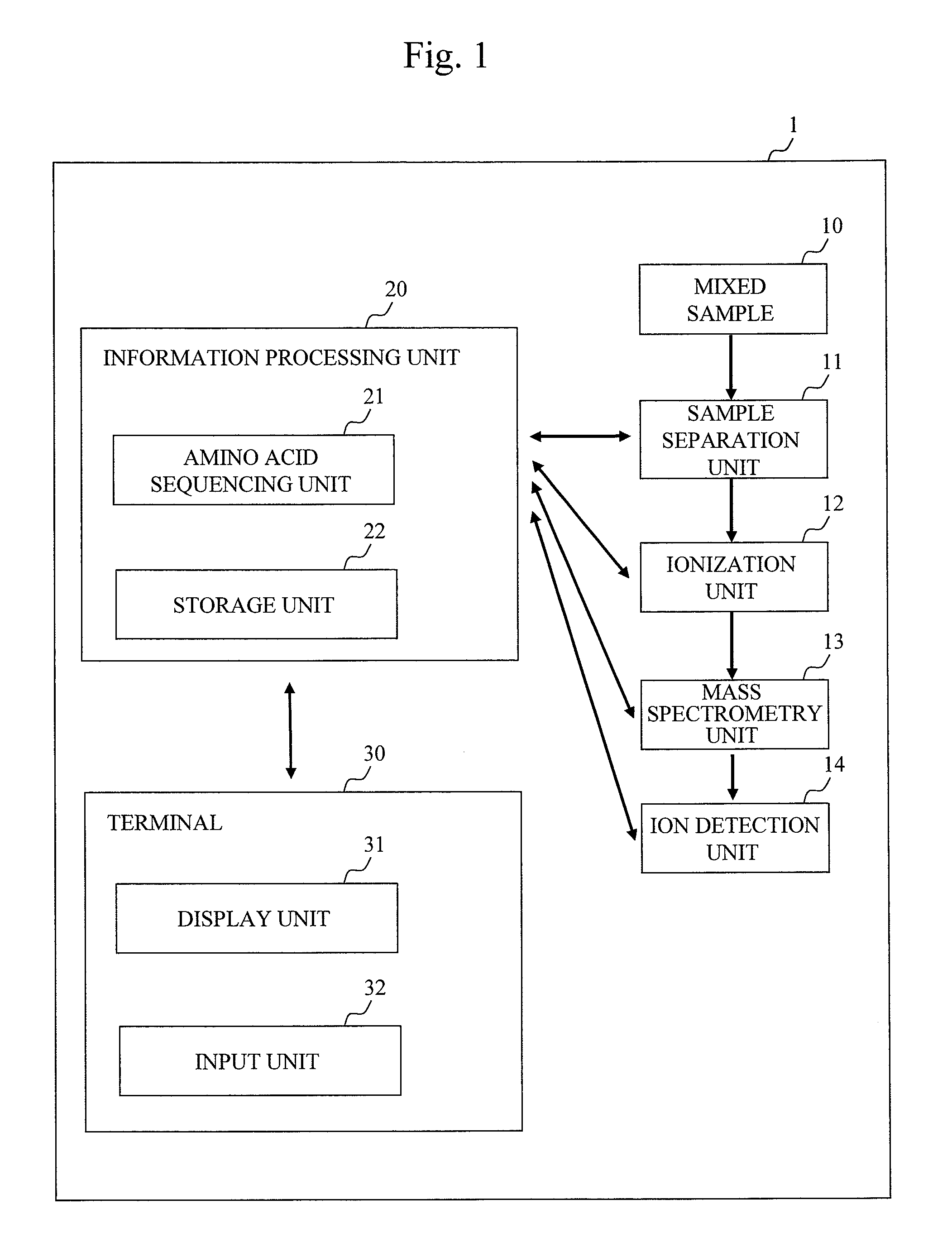Mass spectrometry system and mass spectrometry method
- Summary
- Abstract
- Description
- Claims
- Application Information
AI Technical Summary
Benefits of technology
Problems solved by technology
Method used
Image
Examples
first embodiment
[0034]the present invention will be explained using FIGS. 1 to 8. FIG. 1 is a functional block diagram showing an embodiment of a mass spectrometry system 1. A mixed sample 10 as an analysis target is a mixture of samples containing a specific amino acid labeled with multiple stable isotopes having masses different from each other. 3H (D), 13C, 15N, 17O, 18O can be used as stable isotopes. To prepare labeled samples, various methods can be employed such as a method of labeling cysteine, lysine or tryptophan, a method of culturing a sample in a labeled amino acid medium, a method of preparing synthetic peptide, and the like. Hereinbelow, a description will be given of an example in which Cleavable ICAT (registered trademark) Reagents made by Applied Biosystems are used in a stable isotope labeling method.
[0035]The Cleavable ICAT (registered trademark) Reagents include a heavy labeling reagent (13C10H17N3O3, monoisotopic mass of 236.15) and a light labeling reagent (12C10H17N3O3, mono...
second embodiment
[0067]Next, a second embodiment will be explained using FIG. 9. Here, amino acid sequencing is repeatedly performed on fragment ions having a sufficient intensity by using an ion trap mass spectrometer capable of n-th order mass spectrometry.
[0068]Many steps in this embodiment are common to those in the flow according to the first embodiment shown in FIG. 2. Hereinbelow, a description will be given of only steps newly added. First, in step 300, an initial n value 2 for n-th order mass spectrometry is inputted. Next, in step 301, n-th order mass spectrometry is performed. Ion detection and amino acid sequencing in the next steps are performed in the same manner regardless of an n value. In step 302, it is determined whether or not (n+1)-th order mass spectrometry should be performed. For example, (n+1)-th order mass spectrometry may be determined to be performed when maximum intensity among fragment ions is a threshold value or more. When (n+1)-th order mass spectrometry determined t...
third embodiment
[0069]Next, a third embodiment will be explained using FIGS. 10 and 11. Hereinbelow, a description will be given of an example of a stable isotope labeling method using SERVA ICPL (trademark) Triplex-Kit reagents made by SERVA Electrophoresis GmbH to label samples with three types of stable isotope labels of different masses by using three stable isotopes having masses different from one another.
[0070]The SERVA ICPL (trademark) Triplex-Kit reagents include a heavy labeling reagent (1-(13C61H4)-Nicotinoyloxy-succinimide, monoisotopic mass of 111.0419), a medium-mass labeling reagent (1-(12C61D4)-Nicotinoyloxy-succinimide, monoisotopic mass of 109.0715), and a light labeling reagent (1-(12C61H4)-Nicotinoyloxy-succinimide, monoisotopic mass of 105.0215), each of which is used for labeling lysine. In this case, monoisotopic masses of three types of a specific amino acid (heavy labeled lysine, medium-mass labeled lysine, light leveled lysine) are inputted and registered through a monoiso...
PUM
| Property | Measurement | Unit |
|---|---|---|
| Mass | aaaaa | aaaaa |
| Ratio | aaaaa | aaaaa |
| Frequency | aaaaa | aaaaa |
Abstract
Description
Claims
Application Information
 Login to View More
Login to View More - Generate Ideas
- Intellectual Property
- Life Sciences
- Materials
- Tech Scout
- Unparalleled Data Quality
- Higher Quality Content
- 60% Fewer Hallucinations
Browse by: Latest US Patents, China's latest patents, Technical Efficacy Thesaurus, Application Domain, Technology Topic, Popular Technical Reports.
© 2025 PatSnap. All rights reserved.Legal|Privacy policy|Modern Slavery Act Transparency Statement|Sitemap|About US| Contact US: help@patsnap.com



